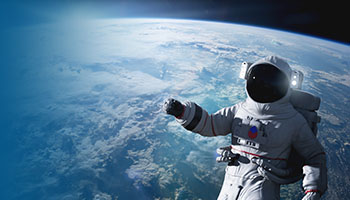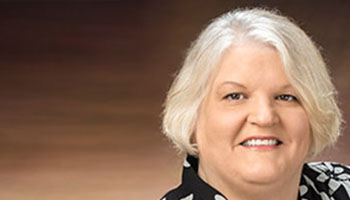HOW CAN WE HELP YOU? Call 1-800-TRY-CHOP
In This Section
Out of This World: CHOP Researchers Help Elucidate Health Effects of Spaceflight

CHOP researchers help elucidate health effects of spaceflight.
Many children want to be an astronaut when they grow up. Researchers at Children’s Hospital of Philadelphia are collaborating with others institutions, including NASA, to hopefully make space travel a bit safer for them.
It’s known that spaceflight poses risks to living organisms, including humans, but the risks have not been explored in detail. By combining human data from the NASA Twin Study and data from mouse models, researchers identified some of the effects that spaceflight has on the body. One of the findings, in which CHOP researchers played a role, is that astronauts experience altered mitochondrial function and DNA damage while in orbit.

Deanne Taylor, PhD
Deanne Taylor, PhD, director of Bioinformatics in the Department of Biomedical and Health Informatics (DBHI) at CHOP, is part of the Analysis Working Group with NASA’s GeneLab — a comprehensive database of multi-omics data, including transcriptomics, proteomics, and metabolomics, as well as epigenetic and molecular data from organism models and humans who went to space.
“A research group headed by NASA was interested in trying to get a big picture of the effects of spaceflight on living organisms, especially those related to humans,” explained Dr. Taylor, who also is a research assistant professor of Pediatrics at the Perelman School of Medicine at the University of Pennsylvania. “The investigators on the NASA GeneLab Analysis Working Group were interested in trying to build a more holistic picture of these effects.”
Previous data from humans, including the Twin Study in which one twin was sent to space and one twin stayed on Earth, had shown that there were physiological changes among astronauts who went to space that later resolved. To determine exactly what these changes were, Dr. Taylor and colleagues from numerous institutions harnessed data from GeneLab and published their findings in the journal Cell.
They analyzed the data from tissue samples from areas of the body that previous studies showed spaceflight affected. For example, one of the known effects of spaceflight is muscle atrophy. Astronauts experience up to a 20 percent loss of muscle mass on spaceflights that lasts five to 11 days. In this study, the researchers identified a significant decrease in the metabolic activity in muscle tissues.
“The common thread found after these analyses is that there is some sort of metabolic disturbance related to mitochondrial function that happens during spaceflight, which supports earlier observations,” Dr. Taylor said. “We suspect that the combination of exposure to microgravity and the higher amounts of radiation exposure causes this metabolic dysregulation.”
The study team then turned their attention to the liver and muscle because these tissues appeared to experience the most multi-omic changes. Their models revealed that the liver had an increase in lipid metabolism and other markers that indicate liver dysfunction.
“These data are evidence that mitochondria and metabolism experience significant changes during spaceflight, in both animal models and humans,” Dr. Taylor said. “They don’t point us exactly to the mechanism of these effects, but they will help guide space health researchers towards intervention studies on the negative effects of space travel.”
The researchers will continue constructing and analyzing more models that are more targeted, hoping to single out causes of the mitochondrial stress, which could lead to the development of therapeutics and treatment strategies.
“Right now, astronauts do exercise in space, and they take vitamins, but there has to be a better way of targeting the specific effects so that they don’t develop these negative effects during spaceflight,” Dr. Taylor said. “That’s the main goal of these projects: to identify the problems and develop interventions.”
Several researchers at CHOP were involved with the study, including three co-first authors: Hossein Fazelinia, PhD, research scientist in DBHI; Man S. Kim, PhD, research fellow in DBHI; Komal Rathi, MS, bioinformatics scientist in DBHI; and Benjamin Stear, MS, bioinformatics engineer in DBHI. Douglas C. Wallace, PhD, director of the Center for Mitochondrial and Epigenomic Medicine (CMEM) and Michael and Charles Barnett Chair of Pediatric Mitochondrial Medicine and Metabolic Disease, and Larry Singh, PhD, a research scientist with DBHI and CMEM, also contributed to the study.